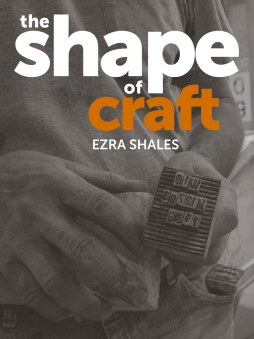
Additional Information
Book Details
Abstract
Today when we hear the word “craft,” a whole host of things come immediately to mind: microbreweries, artisanal cheeses, and an array of handmade objects. Craft has become so overused, that it can grate on our ears as pretentious and strain our credulity. But its overuse also reveals just how compelling craft has become in modern life.
In The Shape of Craft, Ezra Shales explores some of the key questions of craft: who makes it, what do we mean when we think about a crafted object, where and when crafted objects are made, and what this all means to our understanding of craft. He argues that, beyond the clichés, craft still adds texture to sterile modern homes and it provides many people with a livelihood, not just a hobby. Along the way, Shales upends our definition of what is handcrafted or authentic, revealing the contradictions in our expectations of craft. Craft is—and isn’t—what we think.
“Steering the conversation towards anonymous artisans and the sort of craft that doesn’t usually end up on museum pedestals, Shales brings ‘making’ back down to earth where it can connect to our cities and everyday lives.”
— Theaster Gates
“Smart hands indicate intelligence and sensitivity. Alert eyes identify works made with ingenuity. Shales’s book sharpens our visual perception and appreciation of finely crafted objects and environments which have enriched our lives from the beginning of time.”
— Sheila Hicks
“Regardless of craft heroes, doctrine, and orthodoxies, it is the sensory object, however humble, that is celebrated here: ‘Can we respect craft that lies unsigned and underfoot and which oxygenates our lives, giving us tactile joy? To do so can restore our optimism that human manufacturing is healthier for our minds than it is harmful to our environment.’ Shales embraces the role of technology, but also stresses the importance of ‘slow’ craft in a rushed world. Such inclusiveness is an enrichment, not a dilution.”
— David Whiting, Crafts Magazine
“A wide-ranging discussion of questions that shape our understanding of craft.”
— Crafts Magazine
"Shales’ book is a valuable addition to craft scholarship. . . . It is by documenting the multifaceted scope of craft that Shales astounds. . . . His extensive exposition makes plain that craft is rarely the elite object owned and/or displayed by a wealthy patron. More often it is embedded in the everyday material culture that surrounds us."
— Capital and Class
"To be sure, Shales is a gifted, garrulous, and glorious explainer, in essence, he is a philosopher of the factory floor. He writes highly detailed and observant descriptions of tasks, processes, and objects—no easy feat, particularly when describing how something is made—an issue often overlooked in today’s digitized, desensitized, object-free worlds. Art history is a discipline that eschews fieldwork, but the stakes of Shales’s book are just that: a plea for art history to literally think with its hands, instead of just its head, performing research in the field, not only enlivening the narrative, but also, nudging scholarship toward a social imperative."
— Jenni Sorkin, caa.reviews
Ezra Shales is professor of the history of art at Massachusetts College of Art and Design.
Table of Contents
| Section Title | Page | Action | Price |
|---|---|---|---|
| Cover | Cover | ||
| Title Page | 3 | ||
| Imprint Page | 4 | ||
| Contents | 5 | ||
| Introduction | 7 | ||
| One: Archetypes: Who is a Craftsman? | 31 | ||
| Two: Today’s Craftspeople in an Expanded Field | 69 | ||
| Three: Organic or Industrial? Weaving Cane and Welding Steel | 97 | ||
| Four: Weaving as a Magic Carpet Ride | 151 | ||
| Five: Time in Glasscraft | 201 | ||
| Conclusion: Mnemosynthesis | 240 | ||
| Further Reading | 253 | ||
| Acknowledgements | 257 | ||
| Photo Acknowledgements | 261 | ||
| Index | 263 |
